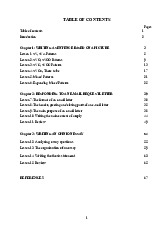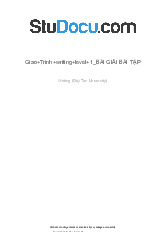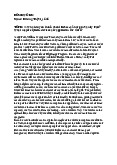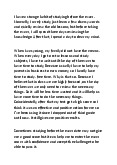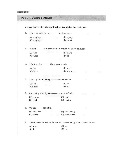

















Preview text:
LESSON 1: COMPOUND SENTENCES (WITH COORDINATOR) A-LANGUAGE FOCUS I. Structure A compound sentence is
two or more independent clauses joined together. A compound
sentence can be formed as follows:
Independent clause, + coordinator + independent clause II. Coordinators
There are seven coordinators, which are also called coordinating conjunctions. You can
remember them by the phrase FAN BOYS (For, And, Nor, But, Or, Yet, So). The following
sentences illustrate the meanings of the seven FAN BOYS coordinators. To add a reason for
Japanese people live longer than most other nationalities, for they eat healthful diets.
To add a similar, equal idea and
They eat a lot of fish and vegetables, and they eat lightly.
To add a negative equal idea nor
They do not eat a lot of red meat, nor do they eat many dairy products.
Note: Nor means “and not.” It joins two negative independent clauses. Notice that question
word order is used after nor. To add an opposite idea but
Diet is one factor in how long people live, but it is not the only factor.
To add an alternative possibility or
However, people should limit the amount of animal fat in their diets, or they risk getting heart disease.
To add an unexpected or surprising continuation yet
Cigarette smoking is a factor in longevity, yet Japanese and other long-lived Asians have a very high rate of tobacco use.
To add an expected result so
Doctors say that stress is another longevity factor, so try to avoid stress if you wish to live a longer life.
Note: - There is a comma after the first independent clause.
- But and yet have similar meanings: They both signal that an opposite idea is coming. is But
preferred when the two clauses are direct opposites. When the second clause is an unexpected
or surprising continuation because of information given in the first clause, yet is preferred.
(But is acceptable for both meanings; yet for only one meaning.) 1 Compare:
I want to study art, but my parents want me to study engineering, (direct opposite)
I am very bad at math, yet my parents want me to study engineering, (surprising continuation
after “I am very bad at math”) B-LANGUAGE PRACTICE Use correct coordinator:
1.Jaewon was cold, _______ he put on a coat.
2. Maria tried to read a novel in French, _______ it was too difficult.
3. To get from Vancouver to Victoria, you can fly, _______ you can ride the ferry.
4. I bought a bottle of wine, _______ we drank it together.
5. The waiter was not very nice, _______ the food was delicious.
6. I went to buy a Rolling Stones CD, _______ the shop didn't have it.
7. Anna needed some money,_______ she took a part-time job.
8. There's so much rain lately! Maybe it's because of El Nino, _______ maybe it's just coincidence.
9. Julie has a guitar, _______ she plays it really well.
10. The concert was cancelled, _______ we went to a nightclub instead. C-PRACTICE IN TOEIC I. Building Language a-
Give nouns, verbs or coordinators which may be used to describe pictures 1-6.
Compare with your friends. b-
Complete the following pictures 1-6 with the given words: so and stops so
talking listening hung and sold 2
1. The girl wants to get off, so the
4. An agreement has been reached, bus………………….
………....………….they are shaking hands.
2. The merchant uses ice, ………….he
5. The man is listening to the information, can keep the fish fresh.
….................. he is taking notes.
3. The clothes are ………on the street,
6. The businessman is ………....to the woman,
and a woman is choosing an item.
and she is ……………..carefully to what he is saying. II. Tactic Practice
1. Put the words in the correct order 3
1. stopped/ got/ girl/ off / school bus/
4. listening to/ is/ the woman/ the man/ the/ the/ and and/ explaining/ her/ is.
2. got/ the girl/ medals/ for/ the/ gold/
5. come to/ the teacher/ talk/ wants to/ she/ won/ races/ three/ all. students/ so/ they/ class.
3. kinds/ many/ of clothes/ are/and /on
for sale/ them/ there are/ labels.
6. writing/ down/the information/ the
man/can’t/ or/ he/ is/ it / remember
2. Make sentences about the pictures with the suggested words 4
1. set up/ for/ come
………………………………… ………..
4. late/ wait/ so
………………………………… ………..
………………………………… ………..
…………………………………
2. expensive / but / buy ……….
………………………………… ………. 5. hot/ park/ so
……………………………………….
…………………………………….....
3. sunny/ so/ open
…………………………………………….
…………………………………………….
6. over/ and/ class
………………………………… ……….. 5
………………………………… ………..
………………………………… ……….. III. Test Practice
In this part of the test, you will write ONE sentence that is based on a picture. With each
picture, you will be given two words or phrases that you must use in your sentence. You can
change the forms of the words and you can use the words in any order.
1. birthday/ so/ celebration 4. break/ and
………………………………………….
…………………………………………
………………………………………….
………………………………………… 2. famous/ come / so 5. outside/ for/ phone
…………………………………………
……………………………………………
…………………………………………
…………………………………………… 3. dirty/ wash / and 6. hold/ write/ and 6
………………………………………
…………………………………………….
………………………………………
…………………………………………….
LESSON 2: COMPOUND SENTENCES
(WITH CONJUNCTIVE ADVERBS) A-LANGUAGE FOCUS I. Structure
A second way to form a compound sentence is as follows:
Independent clause; + conjunctive adverb, + independent clause
Ex: Salt water boils at a higher temperature than freshwater; therefore, food cooks faster in salt water. II. Conjunctive adverbs
To add a similar, equal idea also
Community colleges offer preparation for many occupations; besides
also/besides/furthermore/ in addition/moreover, they prepare students to transfer to a furthermore
four-year college or university. in addition moreover
To add an unexpected or surprising continuation however
The cost of attending a community college is low; nevertheless
however/nevertheless/nonetheless/still, many students need financial aid. nonetheless still
To add a complete contrast
on the other hand Tuition at a community college is low; on the other hand/in contrast, tuition at private in contrast schools is high.
To give an alternative possibility Otherwise
Students must take final exams; otherwise, they will receive a grade of incomplete.
To add an expected result 7 accordingly
Native and nonnative English speakers have different needs; accordingly/as a result/ as a result
consequently/hence/therefore/thus, most schools provide separate English classes for consequently each group. hence therefore To add an example for example
Most colleges now have a writing requirement for graduation; for example/for for instance
instance, students at my college must pass a writing test before they register for their final semester.
Note: Put a semicolon before and a comma after the conjunctive adverb.
Several transition signals, such as on the other hand, as a result, and for example, act like
conjunctive adverbs; they can also connect independent clauses with a semicolon and a comma. B-LANGUAGE PRACTICE
Choose the correct conjunctive adverbs
1. The work was new to me………. , it did not seem difficult. (Consequently, Nevertheless)
2. He is old…………. , his mind is still active. (Nonetheless, Therefore)
3. It was very misty. ……….., we could not get a clear view of the mountain. (Hence, However)
4. We had walked several miles……….. , we did not feel tired. (Accordingly, Still)
5. She is a talented actress…………. , she is very beautiful. (Moreover, Thus)
6. We take the bus every day………. , we are familiar with the bus route. (Nevertheless, Thus)
7. The child was sleepy………… , we went home early. (Otherwise, Therefore)
8. The food was delicious………… , the service was excellent. (Likewise, Nevertheless)
9. We looked everywhere. ………, we could not find the keys. (However, Thus)
10. The book is long…………… , the vocabulary is difficult. (Consequently, Furthermore) C-PRACTICE IN TOEIC I. Building Language
a- Give some nouns, verbs, conjuctive adverbs which may be used to describe pictures
1-6. Compare with your friends.
b- Complete the following about pictures 1-6 with the given words:
therefore however meeting
suitcase empty got out of
8 2. There is a conference; ………….; there
1. The restaurant is open; however, it
are many cars in front of the building.
is ..................................... 5
3. The tables are set up;…………, there is
. The man is walking; besides, he is holding no one in the restaurant. a ……………….
4. The man wanted some fresh air; therefore,
6. They are in the ………….; therefore, they he …………..…the car. are wearing formal suits. 9 II. Tactic Practice
1. Put the words in the right order.
1. foggy/ however/ many/ it/ was/ cars/
there/ were/ on the street/ this morning.
4. are/ sale/ the goods/ on/ hence/
customers/ are/ the shop/ in/ there/ many.
2. The autumn/ coming/ as a result/ yellow
leaves/ falling/ is/ down/ are.
5. explain/ trying to/ the woman/ is/
nevertheless/ understands/ no one/ her.
3. many/ tools/ it/ has/ workshop/ small/ the/ however/ is. 10
6. focusing on/ the exam/ the students/
otherwise/ on time/ can’t/ finish/ are/ th
1. tree/ therefore/ damage
2. vegetables/ besides/ price 11 12 13
2. Make sentences about the pictures with the suggested words 3. close/ thus/ late
5. break/ fix/ as a result
………………………………………….
……………………………………
………………………………………….
………………………………………
4. exercise/ therefore/ help 6. hold/ talk/ also 14
……………………………………….. ………………………………………
……………………………………….. ……………………………………… III. Test Practice
In this part of the test, you will write ONE sentence that is based on a picture. With
each picture, you will be given two words or phrases that you must use in your sentence.
You can change the forms of the words and you can use the words in any order.
1. work/ therefore/ stressed 15 2. cold/walk/ however 16 3. winter/ trees/ hence
5. excited/ thus/ agreement
…………………………………………… …..
……………………………………………
…………………………………………… …..
…………………………………………… ….. ….. 4. taxi/ however/ stop
6. outside/ weather/ therefore
……………………………………………
…………………………………………… ….. …..
……………………………………………
…………………………………………… ….. ….. 17 18
